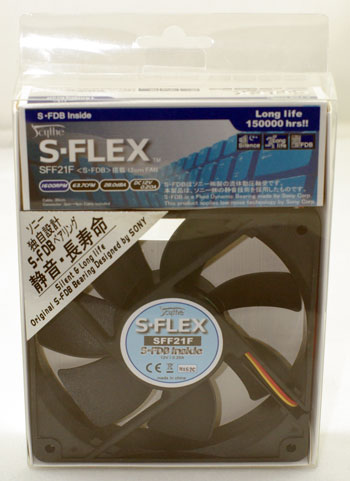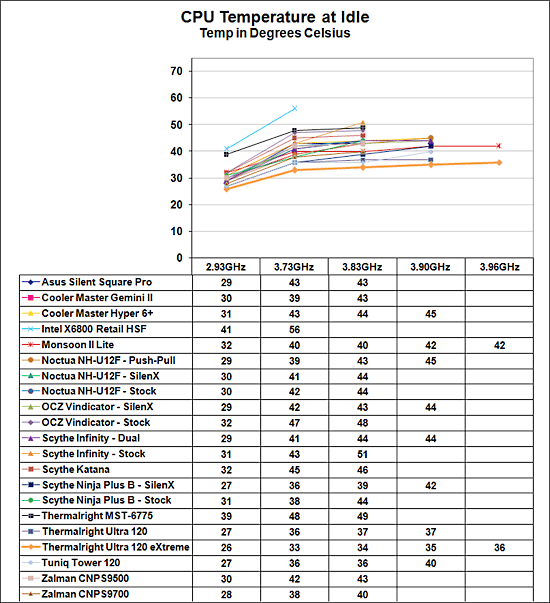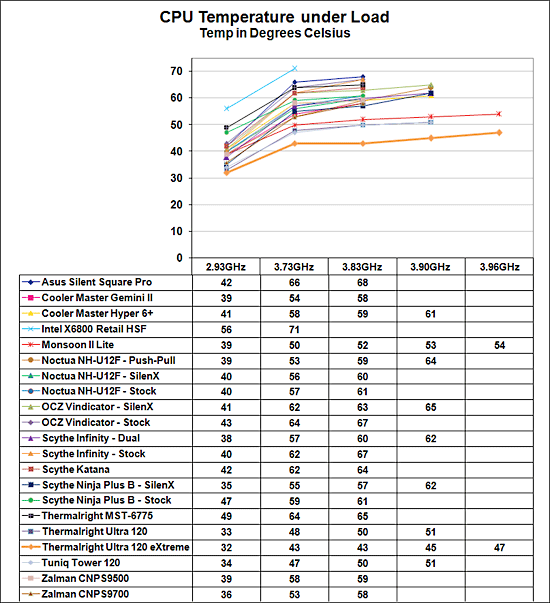UPDATE: Thermalright Ultra-120 eXtreme - Retail
by Wesley Fink on May 4, 2007 3:00 AM EST- Posted in
- Cases/Cooling/PSUs
Test Configuration
The test setup was exactly the same as used in the recent Thermalright Ultra-120 and Ultra-120 eXtreme preview. All the components of the test bench remained the same.

All cooling tests were run with the components mounted in a standard mid-tower case. The idle and stress temperature tests are run with the case closed and standing as it would in most home setups. We do not use auxiliary fans in the test cooling case, except for the Northbridge fan attached to the 680i for overclocking.
We tested with the same Scythe S-FLEX fan used in the Thermalright Ultra-120 review and the original Thermalright Ultra-120 eXtreme preview. This excellent fan moves a lot of air, but still keeps noise low with the Sony developed Fluid Dynamic Bearing on the fan motor. All testing was with a single fan, as in the earlier Thermalright reviews.
Scaling of Cooling Performance
Across stock speed and all overclocks the retail Thermalright Ultra-120 eXtreme produced temperatures either identical to the prototype review or within 1C of the previous test results. These are considered equivalent results and they verify that performance of the retail Thermalright Ultra-120 eXtreme is the same as we measured earlier.
The Ultra-120 and Tuniq Tower 120 set some very high performance standards for effective cooling in overclocking. By 3.73GHz, the highest stable overclock with the Intel retail HSF, the temperature at idle was 56C. This compared to 36C with both the Ultra-120 and the Tuniq Tower 120. The extra heatpipes of the Ultra-120 eXtreme lower this to an even better 33C. By 3.90 GHz, the previous best overclock, the idle for the Tuniq is 40C and the Ultra-120 is 37C. The Thermalright Ultra-120 eXtreme drops the idle 2C lower to 35C, and is still at 36C at the highest stable overclock of 3.94GHz. This is very close to the performance level of the Monsoon II which uses active TEC cooling and not air alone.
Cooling efficiency of the Ultra-120 eXtreme under load conditions was the best tested so far by a wide margin. Compared to the Ultra-120, Tuniq Tower 120 and other recently top CPU coolers it is clear that the extra heatpipes in the Ultra-120 eXtreme are very effective in extending cooling performance.
As you can see in the chart above the cooling efficiency of the Ultra-120 eXtreme under load is striking. Where the Tuniq Tower 120 and Ultra-120 mirror each other from 2.93GHz to 3.90GHz, the Thermalright Ultra-120 eXtreme creates a new performance curve at a lower temperature. The Tuniq and Ultra-120 are at 47/48 at 3.73GHz compared to the Intel retail at 71C. The Ultra-120 eXtreme shatters those cooling results by maintaining 43C.
The advantage increases even more as the overclock is raised. By 3.90 GHz, which is the highest overclock the Tuniq and Thermalright Ultra-120 could reach with stability, the Tuniq and Ultra-120 are both at 51C, which was the best performance among coolers tested so far. The Ultra-120 eXtreme, which is the same cooler as the Ultra-120 with just two additional heatpipes, bests both previous leaders by 6C with a 3.90GHz temperature of 45C.
Overclocking
The highest stable overclock we could achieve with the retail eXtreme was 3.93 GHz compared to the 3.94GHz achieved in the original review. Both results are higher than any achieved with any other cooler tested so far. We suspect this tiny difference is the result of either normal variation in test results, or even more likely the 2C higher ambient temperature in our test room compared to the room temperature in the initial review.
The test setup was exactly the same as used in the recent Thermalright Ultra-120 and Ultra-120 eXtreme preview. All the components of the test bench remained the same.
| Cooling Performance Test Configuration | |
| Processor | Intel Core 2 Duo X6800 (x2, 2.93GHz, 4MB Unified Cache) |
| RAM | 2x1GB Corsair Dominator PC2-8888 (DDR2-1111) |
| Hard Drive(s) | Hitachi 250GB SATA2 enabled (16MB Buffer) |
| Video Card | 1 x EVGA 7900GTX - All Standard Tests |
| Platform Drivers | NVIDIA 9.53 |
| NVIDIA nTune | 5.05.22.00 (1/16/2007) |
| Video Drivers | NVIDIA 93.71 |
| CPU Cooling | Thermalright Ultra-120 eXtreme Cooler Master Gemini II Noctua NF-U12F ASUS Silent Square Pro Scythe Ninja Plus Rev. B OCZ Vindicator Thermalright Ultra 120 Scythe Infinity Zalman CNS9700 Zalman CNS9500 CoolerMaster Hyper 6+ Vigor Monsoon II Lite Thermalright MST-9775 Scythe Katana Tuniq Tower 120 Intel Stock HSF for X6800 |
| Power Supply | OCZ PowerStream 520W |
| Motherboards | EVGA nForce 680i SLI (NVIDIA 680i) |
| Operating System | Windows XP Professional SP2 |
| BIOS | Award P24 (1/12/2007) |

All cooling tests were run with the components mounted in a standard mid-tower case. The idle and stress temperature tests are run with the case closed and standing as it would in most home setups. We do not use auxiliary fans in the test cooling case, except for the Northbridge fan attached to the 680i for overclocking.
We tested with the same Scythe S-FLEX fan used in the Thermalright Ultra-120 review and the original Thermalright Ultra-120 eXtreme preview. This excellent fan moves a lot of air, but still keeps noise low with the Sony developed Fluid Dynamic Bearing on the fan motor. All testing was with a single fan, as in the earlier Thermalright reviews.
Scaling of Cooling Performance
Across stock speed and all overclocks the retail Thermalright Ultra-120 eXtreme produced temperatures either identical to the prototype review or within 1C of the previous test results. These are considered equivalent results and they verify that performance of the retail Thermalright Ultra-120 eXtreme is the same as we measured earlier.
 |
| Click to enlarge |
The Ultra-120 and Tuniq Tower 120 set some very high performance standards for effective cooling in overclocking. By 3.73GHz, the highest stable overclock with the Intel retail HSF, the temperature at idle was 56C. This compared to 36C with both the Ultra-120 and the Tuniq Tower 120. The extra heatpipes of the Ultra-120 eXtreme lower this to an even better 33C. By 3.90 GHz, the previous best overclock, the idle for the Tuniq is 40C and the Ultra-120 is 37C. The Thermalright Ultra-120 eXtreme drops the idle 2C lower to 35C, and is still at 36C at the highest stable overclock of 3.94GHz. This is very close to the performance level of the Monsoon II which uses active TEC cooling and not air alone.
Cooling efficiency of the Ultra-120 eXtreme under load conditions was the best tested so far by a wide margin. Compared to the Ultra-120, Tuniq Tower 120 and other recently top CPU coolers it is clear that the extra heatpipes in the Ultra-120 eXtreme are very effective in extending cooling performance.
 |
| Click to enlarge |
As you can see in the chart above the cooling efficiency of the Ultra-120 eXtreme under load is striking. Where the Tuniq Tower 120 and Ultra-120 mirror each other from 2.93GHz to 3.90GHz, the Thermalright Ultra-120 eXtreme creates a new performance curve at a lower temperature. The Tuniq and Ultra-120 are at 47/48 at 3.73GHz compared to the Intel retail at 71C. The Ultra-120 eXtreme shatters those cooling results by maintaining 43C.
The advantage increases even more as the overclock is raised. By 3.90 GHz, which is the highest overclock the Tuniq and Thermalright Ultra-120 could reach with stability, the Tuniq and Ultra-120 are both at 51C, which was the best performance among coolers tested so far. The Ultra-120 eXtreme, which is the same cooler as the Ultra-120 with just two additional heatpipes, bests both previous leaders by 6C with a 3.90GHz temperature of 45C.
Overclocking
The highest stable overclock we could achieve with the retail eXtreme was 3.93 GHz compared to the 3.94GHz achieved in the original review. Both results are higher than any achieved with any other cooler tested so far. We suspect this tiny difference is the result of either normal variation in test results, or even more likely the 2C higher ambient temperature in our test room compared to the room temperature in the initial review.










44 Comments
View All Comments
FXi - Friday, May 4, 2007 - link
Congrats for taking the time to go back and test a retail version. That's a feather in your cap for sure.We of course want to see this compared to the IFX cooler, with and without the back cooling device.
Way to go :)
Questions: was the cooler mounted horizontally with the fan facing up? Were you using push or pull on the fan?
Again our thanks!
Wesley Fink - Friday, May 4, 2007 - link
We assumed readers would understand the setup was the same as the Ultra 120 and Ultra 120 Extreme tests, but we added the statements on how we test and that we tested with a SINGLE fan only to the Test Configuration page. We hope this makes test conditions a little clearer.Syran - Friday, May 4, 2007 - link
Was this done with 2 fans in a push/pull method, or 1 single fan?puffpio - Friday, May 4, 2007 - link
single fanSpacecomber - Friday, May 4, 2007 - link
I understand the economy and potential convenience of getting the all the data, for all the heatsinks, and all the CPU speed points into one graph, but maybe we're close to (or have already reached) the point of these graphs being too busy to be helpful.Maybe breaking the data into a bar graph for each CPU speed point (that would be five graphs at this point) would make it easier to see what is going on.
Besides, more graphs means more pages, which equals more advertising space. ;-)
crimson117 - Friday, May 4, 2007 - link
It helps to click the graph for the larger version.And the graph is crowded because the results are similar - so to tell you the truth, when the difference is only one or two degrees, you're better off making your decision on ease of installation, weight, cost.
Wesley Fink - Friday, May 4, 2007 - link
The test environment is included in every full review, but since this was an UPDATE we tried to keep the data compact. From a recent cooler review:"All cooling tests are run with the components mounted in a standard mid-tower case. The idle and stress temperature tests are run with the case closed and standing as it would in most home setups. We do not use auxiliary fans in the test cooling case, except for the Northbridge fan attached to the 680i for overclocking."
For these tests the Ambient room temp was measured as 22C, past tests have been 20C. This is mentioned in the review.
Axbattler - Friday, May 4, 2007 - link
"(unless you're going for silence and want to run fanless)"I understand that AT's primary objective is not silencing PCs. But with that comment, I wonder how well the eXtreme perform fanless compared to the Scythe Ninja - one of the favorite at SPCR.
The Ninja is no longer the best when with all fans, but it tends to scale gracefully as slower fans are used, or no fan at all (due to wider spacing).
TA152H - Sunday, May 6, 2007 - link
I agree, they seem to have some weird fetish about saying things without wanting to substantiate them. I mean, why put out that remark if you're not going to elaborate on it with some information?It's kind of like the Bearlake remarks earlier, about how they are surprising. I think it's a childish need to act like they know something you want to. Or stupidity. Either way, they are inappropriate and irritating.
Wesley Fink - Sunday, May 6, 2007 - link
There's no private info about fanless operation. I didn't supply data on fanless operation because our current test bed is not well set up for fanlees, and therefore I didn't want to mislead readers with fanless performance data that is likley much poorer than you can actually achieve with the Ultra-120 eXtreme. We have explained this in every review recently of a cooler that could be used fanless.We did test fanless operation in our review of the base Ultra-120. You can look back at those results and expect performance at least that good and probably better.